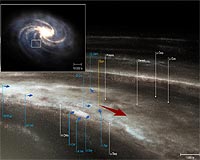 |
Tokyo, Japan (SPX) Feb 18, 2011 The fruits of the Strategic Explorations of Exoplanets and Disks with Subaru (SEEDS) project, led by Motohide Tamura of NAOJ (National Astronomical Observatory of Japan), continue with another remarkable discovery: The telescope has directly and sharply imaged two young stars that reveal how planets may have formed from their disks. No other telescopes, whether ground-based or in space, have ever penetrated so close to central stars, showing the details of their disks. One of the images is of the disk of the very young star AB Aur in the constellation Auriga. The star is only about one million years old and is surrounded by its protoplanetary disk, a structure of gas and dust from which planets are likely to form. The image displays high spatial resolution as well as high contrast within the disk near its central star; it reveals, for the first time, the fine structures of a disk orbiting closer to its star than Neptune's distance from the Sun in our solar system. AB Aur's disk has double rings that are tilted from the equatorial plane; a void of material between the rings; and a center that does not coincide with the position of the star. These irregularities suggest that at least one giant planet is affecting the features of the disk. The other image from the project is that of another young star, LkCa 15, which is several million years old. Although previous works speculated that there was a gap in its disk, this is the first direct imaging of a central gap in the disk. The lack of material in the vicinity of the central star implies that a giant planet is sweeping up the disk's leftover materials that the central star did not swallow. Overall, these first two direct images of the detailed structure of the protoplanetary disks provide strong evidence for planet formation within a system on the scale of our solar system. The influence of heavy planets is likely to have produced the irregular features of the disks. The SEEDS project will continue for five years, allowing astronomers to search the universe for exoplanets and their protoplanetary disks, in an ongoing quest to decipher how planetary systems form. Recent and future findings from the project may eventually contribute to our understanding of how Earth-like habitable zones develop. The article with results for AB Aur has been accepted by the Astrophysical Journal for publication in 2011. The results for LkCa 15 were previously published in the Astrophysical Journal (Thalmann et al. 2010, Ap.J., 718, 87).
Share This Article With Planet Earth
Related Links National Astronomical Observatory of Japan Lands Beyond Beyond - extra solar planets - news and science Life Beyond Earth
 New Instrument Will Help Confirm Kepler Planet Finds
New Instrument Will Help Confirm Kepler Planet FindsBoston MA (SPX) Feb 15, 2011 The search for planets outside our solar system continues to heat up. NASA's Kepler spacecraft has located more than 1,200 planetary candidates, however confirming them remains a challenge. In some circumstances, an eclipsing binary star can mimic the shallow dimming due to a planet crossing in front of its star. Ground-based measurements are needed to verify an orbiting world by spotting the gr ... read more |
|
| The content herein, unless otherwise known to be public domain, are Copyright 1995-2010 - SpaceDaily. AFP and UPI Wire Stories are copyright Agence France-Presse and United Press International. ESA Portal Reports are copyright European Space Agency. All NASA sourced material is public domain. Additional copyrights may apply in whole or part to other bona fide parties. Advertising does not imply endorsement,agreement or approval of any opinions, statements or information provided by SpaceDaily on any Web page published or hosted by SpaceDaily. Privacy Statement |